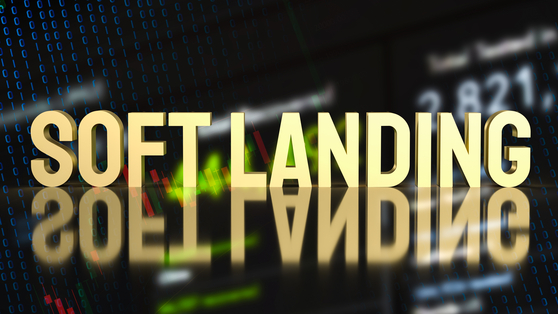How to break away from the textbook

Lee Sang-ryeol
The author is an editorial writer of the JoongAng Ilbo.
Even with the interest rate hovering at a 22-year high, the U.S. economy is heading to a soft-landing by controlling inflation without triggering a recession. The U.S. Federal Reserve began uplifting the benchmark rate from March 2022 from the long-held zero territory, as inflation began to heat up amid the winding-down of the Covid-19 pandemic. At that time, Russia’s invasion of Ukraine, on top of the destabilized global supply chains, sent energy and food prices soaring. U.S. interest rate was raised at the most aggressive pace in 30 years. The Federal funds rate now ranges at 5.25-5.50 percent, up 525 basis points from 0-0.25 percent in January last year.
The rapid rate increase raised alarms in Wall Street about an inevitable recession. Economists joined the chorus to warn against an inevitable recession for the U.S. economy. A survey by the Wall Street Journal in October last year showed pundits predicting a 63 percent chance of the economy slipping into a recession within one year.
But the U.S. economy defied all the odds. The headline consumer price index in June gained 3 percent on year, one third of the 9.1 percent at the peak a year ago. The core personal consumption expenditures (PCE) price index the Fed watches closely as a gauge of inflation rose 4.1 percent in June, the slowest since 3.7 percent in September 2021.
In the textbook theory, if the interest rate goes up, prices come down, but at the same time it cools the economy and the job market. So, a hard-landing is unavoidable. But the U.S. job market remains solid as ever. The unemployment rate in July was 3.5 percent, a record low. The labor participation rate of the prime working population aged between 25 and 54 has hit 83.4 percent, topping the pre-pandemic level. Average wage per hour also rose 4.4 percent on year, outpacing the inflation gain.
Various data suggests that the U.S. is winning its war on inflation without going into a recession. In a press conference last month, Fed Chair Jerome Powell said the U.S. central bank was crossing off recession in its forecast.

Different from the 2007 financial crisis
So, how could the U.S. beat the economic theory?
Harvard Business Review (HBR) points to the resilience of the U.S. economy defying doomsayers. The journal listed its four strengths in the labor market, consumption, housing market, and financial system. At the center of the resilience was a tight labor market. Despite the steep increases in the interest rate and cost, employers restrained layoffs in contrast with the aftermath of the Wall Street-triggered 2007-2009 financial crisis.
The Wall Street Journal reported that the employers learned that layoffs are not just hard but ineffective, as new hires cannot completely replace experienced workers. Unlike other major tech companies, Apple was able to avoid mass layoffs in the aftermath of the pandemic. Its CEO Tim Cook in an interview emphasized that layoffs should be a last resort.
A prudent approach to layoffs in the U.S. labor market — which traditionally uphold flexibility — stems from unprecedented labor shortages since the pandemic. According to the U.S. Chamber of Commerce, 120,000 businesses shut down at the peak of the pandemic, wiping out more than 30 million jobs. Many of the laid-off workers have not returned to work. The anti-immigration policy under President Donald Trump also played a part in the labor shortage. Net immigrants that reached 1,049,000 between 2015 and 2016 under Barack Obama’s administration shrank to 247,000 between 2020 and 2021.
That led to labor shortages when the economy recovered from pandemic. In the meantime, the demand for labor increased. The mass manufacturing campaigns led by the Inflation Reduction Act and the CHIPS and Science Act under the Biden administration created a number of jobs for Americans by stimulating investments by the federal government and private companies. Start-up fever also did not cool down. According to the U.S. Chamber of Commerce, 10 million entrepreneurs registered as new businesses over the last two years.
Stable jobs heat up consumption
The pickup in consumer spending owes largely to the robust employment. Stable job and income buttressed household finances for spending. That’s not all. U.S. consumers had leftovers from the government’s generous unemployment compensations, stimuli checks, as well as the returns from strong equities during the pandemic period in their wallets. Savings by Americans surged by $3.7 billion during the pandemic, according to a study by Oxford Economics.
Another factor behind the resilience of the U.S. economy is the gradual decrease in the household debt-to-GDP ratio which peaked at 100.5 percent in the fourth quarter of 2007 in the runup to the Wall Street meltdown. The ratio briefly hit above 80 percent during pandemic, but fell to 73 percent by the first quarter of this year. That is in sharp contrast with other countries whose consumption recovery was constrained even after the pandemic due to their heavy load of household debt.
Private consumption in the U.S. also increased 1.6 percent on year in the second quarter, which helped back the soft landing of the economy, where domestic demand takes up two-thirds of the GDP.
Another factor behind the resilience was the stable housing market in the U.S., as mortgages usually taken out on long-term fixed rate was less affected by the spike in interest rate. More than 70 percent of American mortgages are financed across a span of 30 years at a fixed rate. Moreover, most of them were lent when the base rate was near zero.
Low mortgage rates sustain housing market
The resilient financial system helped the recovery, too. Silicon Valley Bank, ranking 16th in terms of assets, went bankrupt in March in the second largest bank insolvency in U.S. history. Yet a panicky bank run was effectively reined in by fast moves by the U.S. government and the Fed through their full coverage of deposits and quick arrangement of a merger with First Citizens Bank. HBR noted, “The risk of contagion (from the collapse of SVB) was overestimated, and the ability of policy-makers to avert it was underestimated.”
A soft-landing of the U.S. economy spells good news for the world economy, especially when the contribution from China —the second largest economy — has been waning. The effect from the reopening of China after its rigid lockdowns and Covid-19 restrictions were lifted is less than expected.
No time to pop the champagne
But whether the strength in the U.S. economy can persist remains to be seen, as the impact of the rate hikes on the economy will appear later. The New York Times reminded that such optimism for a soft landing had prevailed during the past recession episodes in 1990, 2000 and 2007 in the wake of a series of interest rate hikes. But soon after the sanguine outlook, the economy each time fell into a recession after the jobless rate shot up and numerous businesses closed. “It is a point of historical caution that is relevant today, when soft-landing optimism is again surging,” the NYT warned.
Still, the Fed and the federal government deserve a compliment for having tamed inflation and keeping employment stable despite steep rate increases. Their navigation towards soft landing provides some tips for Korean authorities.
Korea must increase jobs and reduce debt
The first takeaway is the importance of employment stability. Jobs have the power to run the economy. The ability to generate quality jobs has weakened substantially in the Korean economy. The radical fiscal stimuli program the Biden government implemented to stimulate corporate investment shows how budgetary spending should be spent. The Korean government is still constrained in radical tax cuts and deregulations to support the corporate sector. Industrial policy must not be swayed by anti-business sentiment.
Deleveraging is also an urgent task. Korea’s household debt-to- GDP ratio reached 105 percent in the fourth quarter of last year. Since 76.4 percent of outstanding debt was lent on floating rate terms last year, households stand vulnerable to the shock from rate hikes. Consumption cannot pick up when households are weighed down by their debt burden. The SVB crisis underscores the importance of fast action to prevent an ominous spillover to the financial system. Jobs must be increased, debt decreased, and response to crisis must be swift in order for Korea Inc. to return to the stable growth path as in the past.










with the Korea JoongAng Daily
To write comments, please log in to one of the accounts.
Standards Board Policy (0/250자)